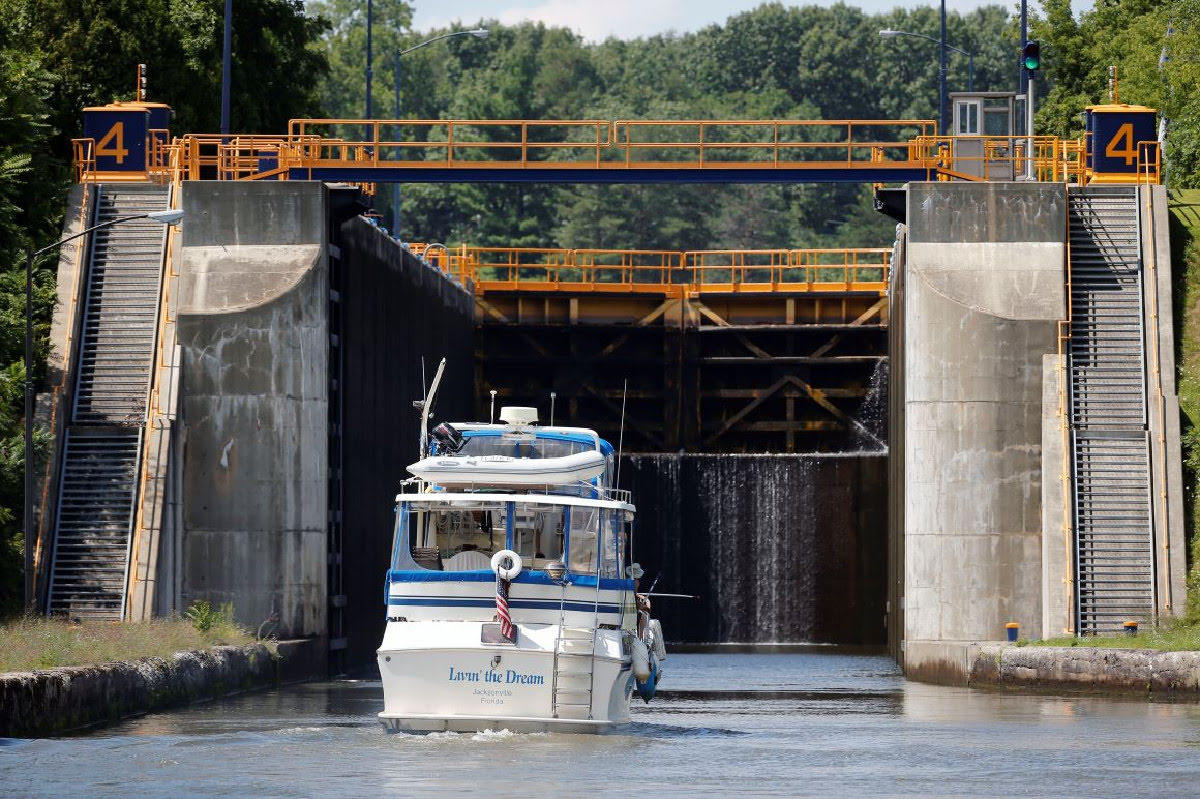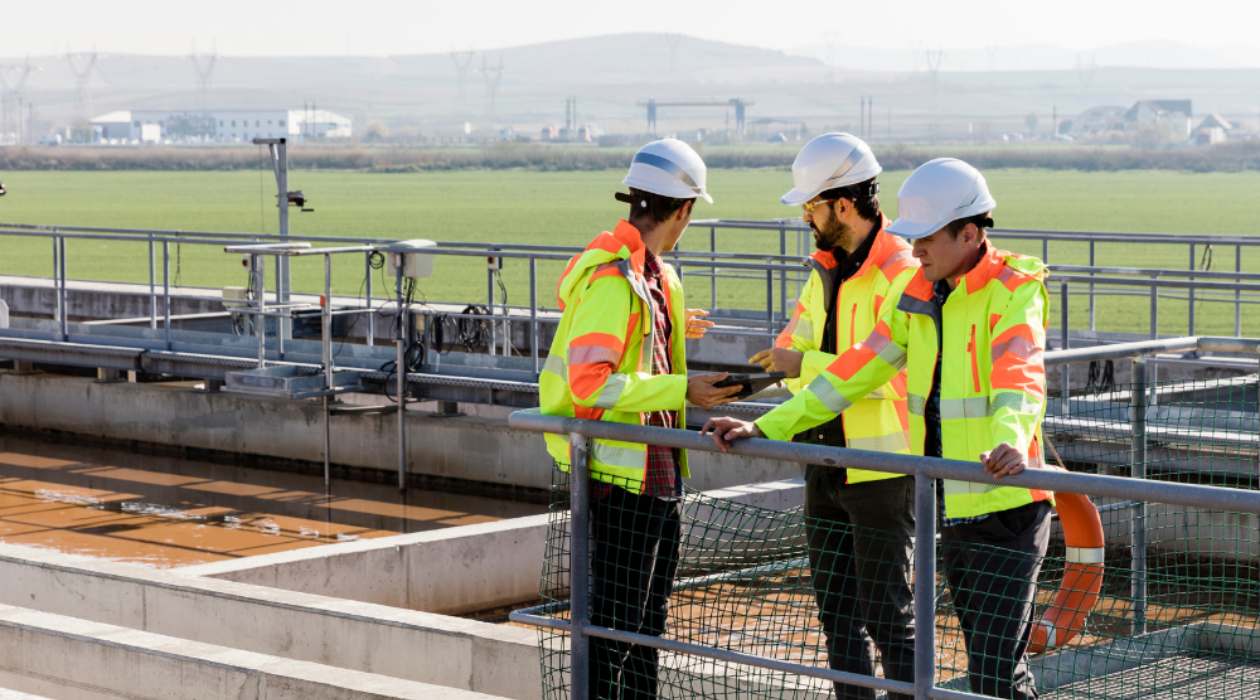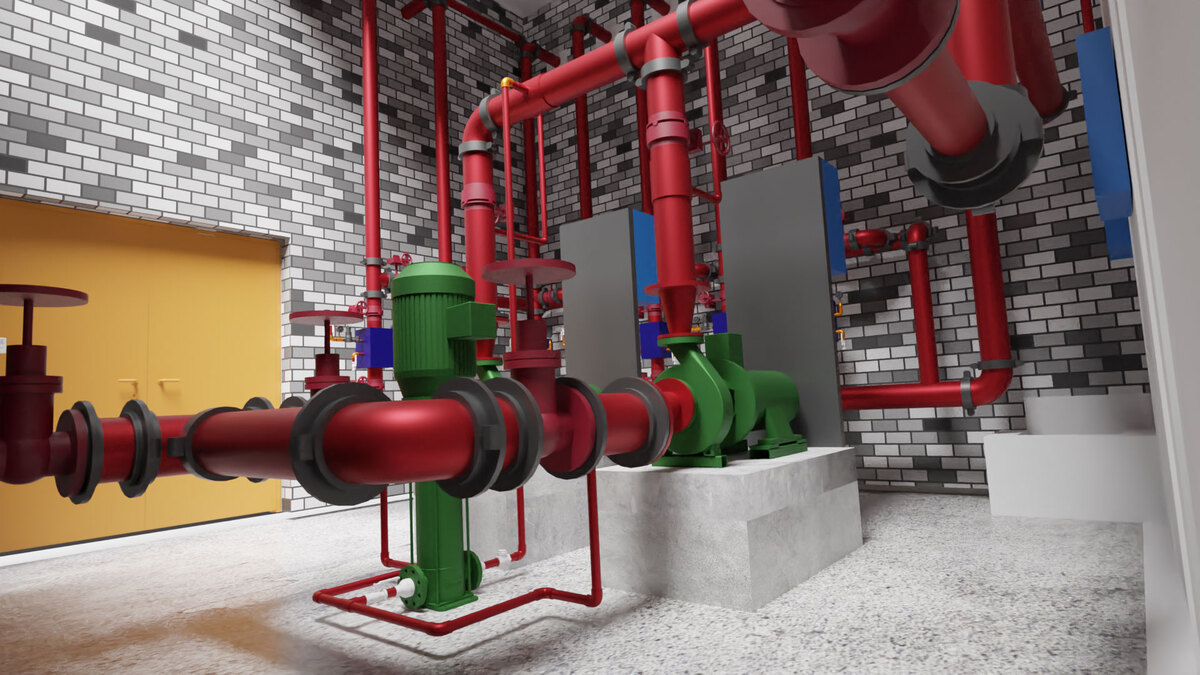Home>diy>Building & Construction>What Was One Result Of The Construction Of The Erie Canal?


Building & Construction
What Was One Result Of The Construction Of The Erie Canal?
Modified: March 6, 2024
One result of the building construction of the Erie Canal was the significant economic growth and development in the surrounding regions.
(Many of the links in this article redirect to a specific reviewed product. Your purchase of these products through affiliate links helps to generate commission for Storables.com, at no extra cost. Learn more)
Introduction
The construction of the Erie Canal in the early 19th century had a profound impact on American history and transformed the economic, social, and political landscape of the United States. This ambitious project connected the Great Lakes with the Atlantic Ocean, providing a vital transportation route that revolutionized trade and commerce.
The Erie Canal, also known as the “Big Ditch,” was a feat of engineering that stretched over 363 miles from Albany to Buffalo, New York. It was completed in 1825 and allowed for the transportation of goods and people at a fraction of the time and cost previously required.
This article examines the significant results of the construction of the Erie Canal, highlighting its economic impact, population growth, industrialization, regional development, influence on transportation, and political significance.
By understanding the multiple facets of the canal’s influence, we can gain a deeper appreciation for its contribution to the growth and development of the United States during this critical period in history. Let’s explore the fascinating outcomes of this monumental construction project.
Key Takeaways:
- The construction of the Erie Canal revolutionized transportation, reducing costs and opening up new markets, which stimulated trade, fostered industrial growth, and facilitated westward migration.
- The Erie Canal’s impact extended beyond economics, driving population growth, cultural diversity, and regional development, while also elevating New York’s political influence and strengthening national unity.
Background of the Erie Canal
The idea of a canal connecting the Great Lakes to the Atlantic Ocean was conceived as early as the 18th century. The need for a reliable and efficient transportation route became apparent as trade and commerce expanded westward. Before the construction of the Erie Canal, the prevailing method of transportation was by water, using rivers and lakes. However, these routes were often unreliable, time-consuming, and suited for small vessels.
In 1817, New York Governor DeWitt Clinton championed the idea of a canal that would link the Hudson River with Lake Erie. It was a bold and visionary proposal that faced opposition and skepticism. Many believed that such an undertaking was impractical and financially unfeasible.
Despite the skepticism, construction on the canal began in 1817, with thousands of laborers toiling for eight years to complete the monumental project. The canal was a remarkable engineering feat, involving the excavation of vast amounts of earth, the construction of locks to lift and lower boats, and the creation of an intricate network of channels and reservoirs.
The construction of the Erie Canal faced numerous challenges, including difficult terrain and the need to overcome natural obstacles such as rivers and swamps. However, engineers and laborers overcame these challenges through ingenuity and hard work, successfully completing the canal on October 26, 1825.
The Erie Canal was an instant success, surpassing expectations and fundamentally changing the way goods were transported in the United States. It quickly became known as the “Wonder of the Western World” and ignited a canal-building boom across the country.
The success of the Erie Canal also spurred the development of other canals, establishing New York City as the premier port in the United States and positioning the state as a center of trade and commerce. The canal became a vital link between the agricultural resources of the Midwest and the markets of the East Coast, facilitating the rapid growth of American industry and urban centers.
The construction of the Erie Canal marked a turning point in American history, ushering in a new era of transportation and setting the stage for the country’s westward expansion. Its impact on various aspects of American society cannot be overstated, as it laid the foundation for the economic, social, and political changes that would shape the nation in the years to come.
Economic Impact
The construction of the Erie Canal had a profound economic impact on the United States, transforming the country into an economic powerhouse and opening up new opportunities for trade and commerce.
One of the significant economic benefits of the Erie Canal was its role in reducing transportation costs. Prior to the canal’s construction, goods were primarily transported by wagon, which was slow, expensive, and limited in the amount of cargo it could carry. With the completion of the Erie Canal, goods could be transported by boat, reducing transportation costs by up to 95%. This dramatic decrease in costs made it more affordable to trade goods over long distances, ultimately stimulating economic growth and facilitating the development of new markets.
The canal also played a vital role in connecting the agricultural resources of the Midwest to the markets of the East Coast. The fertile lands of the Midwest, which were previously inaccessible to coastal markets, could now be easily reached through the canal. This led to increased agricultural production and allowed farmers to sell their products for higher prices, boosting the overall economy.
Furthermore, the Erie Canal created a booming trade industry. The canal’s route connected cities such as Albany, Syracuse, Rochester, and Buffalo, attracting merchants and stimulating the growth of these urban centers. New businesses and industries sprouted along the canal, including mills, factories, and warehouses, which capitalized on the increased accessibility to raw materials and markets. The canal also served as a conduit for the shipment of products such as lumber, flour, and textiles, bolstering trade and supporting the growth of local economies.
The economic impact of the Erie Canal extended beyond New York State. The canal created a direct link between the Midwest and the East Coast, bypassing the slow and costly overland transportation routes that previously existed. This helped to facilitate the expansion of the western territories, as goods from the Midwest could now be easily transported to the large markets of the eastern cities.
Moreover, the canal spurred the growth of other industries, such as banking, insurance, and construction. Financial institutions were established along the canal route, providing loans and financial services to support the growing economy. Insurance companies also flourished, offering coverage for goods transported on the canal. Additionally, the construction of the canal itself created job opportunities for thousands of laborers, further stimulating economic activity.
Overall, the economic impact of the Erie Canal was far-reaching. It revolutionized transportation, reduced costs, stimulated trade, and supported the growth of industries and urban centers. Its success laid the foundation for the economic prosperity of New York State and contributed to the overall economic development of the United States.
Population Growth
The construction of the Erie Canal played a significant role in driving population growth in the regions it traversed, leading to the establishment of new settlements and the expansion of existing communities.
The accessibility afforded by the canal attracted individuals and families from all over the country seeking new economic opportunities. Towns and cities along the canal route experienced rapid population growth as people flocked to these areas to take advantage of the bustling trade and commerce. New settlements sprouted up along the canal, providing homes and livelihoods for those looking to make a fresh start.
The population growth was not limited to the immediate vicinity of the canal. The improved transportation made by the canal connected the eastern ports with the Midwest, opening up vast new territories for settlement. This led to a significant westward migration as people sought to claim land and build new lives in the expanding frontier. The canal became a crucial link between the densely populated regions of the East Coast and the emerging communities of the Midwest.
The population growth along the canal had a profound impact on the demographics of the region. Immigrants from Europe, particularly Ireland and Germany, were drawn to the opportunities provided by the canal and settled in the towns and cities along its route. Their presence brought cultural diversity and contributed to the growth and development of these communities. Additionally, immigrants from other parts of the United States were lured by the promise of economic prosperity and the chance to establish themselves in the thriving canal towns.
The population growth also brought about social changes. The increased population density led to the establishment of schools, churches, and other community institutions. These institutions played a vital role in fostering a sense of community and provided essential services to support the growing population.
Furthermore, the population growth had a positive impact on labor availability. The influx of people along the canal created a larger workforce for industries and businesses. This, in turn, fueled industrialization and economic development as the growing population provided the labor necessary for the operation of mills, factories, and other industrial enterprises.
The population growth spurred by the construction of the Erie Canal had a lasting impact on the regions it passed through. The influx of people, cultural diversity, and development of communities transformed previously rural areas into bustling urban centers. The canal played a critical role in shaping the demographic landscape of the United States, driving westward expansion and fostering a sense of opportunity and progress in the growing nation.
Industrialization
The construction of the Erie Canal was a catalyst for rapid industrialization in the regions it connected. The accessibility provided by the canal spurred the growth of industries and transformed the economic landscape.
One of the key factors that contributed to industrialization was the efficient transportation of raw materials and finished goods. The Erie Canal opened up new markets and allowed for the easy transport of resources from the Midwest to the East Coast. This facilitated the development of industries such as manufacturing, textiles, and agriculture. Raw materials could be transported to factories, where they were transformed into finished goods or processed for sale. The canal’s transportation capabilities allowed manufacturers to access a wider range of resources and distribute their products more efficiently.
The abundance of water resources along the canal route also played a vital role in industrialization. The canal provided a reliable and cost-effective means of harnessing water power for mills and factories. Water turbines were used to power machinery, increasing productivity and reducing reliance on manual labor. The availability of water power attracted entrepreneurs and investors, leading to the establishment of numerous manufacturing enterprises.
The growth of industries along the canal route created new job opportunities, spurring urbanization and population growth. As factories and mills expanded, workers migrated from rural areas to the developing industrial centers. This led to the growth of towns and cities, where workers could find employment and support the growing industries. The concentration of industries along the canal route created economic hubs and laid the foundation for sustained growth and development.
Industrialization also brought technological advancements. As industries grew, there was a demand for new and improved machinery to increase productivity and efficiency. The canal route became a hub for innovation, with inventors and engineers working to develop machinery and techniques that could support the expanding industries. The rapid industrialization along the canal route played a crucial role in propelling the United States into the forefront of global industrial power.
Moreover, the growth of industries along the canal route created a demand for skilled labor. This led to the establishment of vocational schools and training programs, providing workers with the necessary skills to thrive in the industrial sector. The availability of skilled labor further fueled industrialization, as companies had access to a workforce capable of operating complex machinery and driving innovation.
The industrialization brought about by the construction of the Erie Canal had a profound impact on the economic development of the United States. It spurred innovation, created job opportunities, and transformed previously agricultural regions into thriving industrial centers. The canal became a lifeline for industries, providing them with the necessary resources and transportation capabilities to flourish. The resulting industrial growth laid the foundation for the economic prosperity and progress that the nation would experience in the years to come.
The construction of the Erie Canal resulted in a significant decrease in transportation costs, making it cheaper and faster to move goods and people between the East Coast and the Midwest.
Regional Development
The construction of the Erie Canal played a pivotal role in the regional development of the areas it traversed. The canal provided the impetus for the establishment and expansion of towns and cities, as well as the development of infrastructure and the growth of diverse industries.
The presence of the Erie Canal spurred the rapid growth of urban centers along its route. Towns and cities such as Albany, Syracuse, Rochester, and Buffalo flourished as trade and commerce along the canal boomed. These urban centers became hubs for economic activity, attracting merchants, entrepreneurs, and settlers seeking new opportunities. The canal provided a direct link to larger markets and opened up new possibilities for businesses, leading to the establishment of mills, warehouses, and other commercial enterprises. The growth of these urban centers along the canal route fueled regional development and transformed previously rural areas into vibrant economic and cultural centers.
The regional development also extended beyond the immediate canal route. The canal linked the Midwest to the eastern ports, providing an efficient transportation route for goods and a means for settlers to access new lands. This led to the rapid expansion of settlements and the development of agricultural communities in the Midwest. The canal played a crucial role in facilitating westward migration, as settlers sought to take advantage of the opportunities presented by the emerging frontier. The growth of agriculture and the establishment of new settlements further contributed to regional development as infrastructure and services were developed to support the growing population.
The construction of the Erie Canal also spurred the development of vital infrastructure projects. The need to maintain and operate the canal necessitated the construction of canal-related facilities such as storage warehouses, maintenance yards, and lock systems. Additionally, the towns and cities along the canal route invested in building roads, bridges, and other transportation networks to support the growing economic activity. The development of these infrastructure projects created job opportunities and supported the growth of construction-related industries.
Furthermore, regional development was driven by the diversification of industries. The canal provided access to new markets and resources, which led to the growth of manufacturing, agriculture, and other industries. Mills and factories were established along the canal route, leveraging its transportation capabilities and water power to drive industrial growth. The availability of resources and the establishment of supporting industries, such as banking and shipping, further fueled regional development.
The regional development prompted by the Erie Canal had a lasting impact on the areas it connected. It transformed rural landscapes into thriving urban centers and sparked economic growth and diversification. The canal’s influence extended beyond its immediate route, as it facilitated the westward expansion and the development of new communities in the Midwest. The regional development spurred by the canal laid the foundation for sustained economic growth and provided a framework for progress and prosperity in various regions of the United States.
Influence on Transportation
The construction of the Erie Canal had a profound influence on transportation in the United States, revolutionizing the way goods and people were moved across the country.
Prior to the Erie Canal, transportation was primarily reliant on rivers and overland routes, which were often slow, unreliable, and limited in capacity. The canal provided a direct and efficient water route that connected the Great Lakes to the Atlantic Ocean. The ease of navigation and the ability to transport larger quantities of goods significantly reduced the time and cost required for transportation.
The Erie Canal’s influence on transportation extended beyond the goods it transported. The canal also facilitated the movement of people, allowing for greater opportunities for travel and migration. Passengers could now travel quickly and comfortably along the canal route, opening up new avenues for exploration, settlement, and commerce. The canal served as a crucial link between the agricultural resources of the Midwest and the growing urban centers of the East Coast, providing a reliable transportation option for people seeking opportunities in new territories.
The success of the Erie Canal inspired the construction of additional canals throughout the United States. For example, the success of the Erie Canal prompted the construction of the Illinois and Michigan Canal, which connected the Great Lakes to the Mississippi River. These canals facilitated the movement of goods and people, fostering economic growth and regional integration.
Moreover, the construction of the Erie Canal sparked innovations in transportation technology. The canal’s success paved the way for the development of steamboat travel on the Great Lakes and other waterways. Steam-powered vessels provided a faster and more reliable means of transportation, further expanding trade and opening up new markets.
The influence of the Erie Canal on transportation extended to the development of infrastructure. The canal became a catalyst for the construction of roads, bridges, and other transportation networks, connecting the canal to surrounding areas and facilitating the movement of goods to and from the canal. These infrastructure projects not only supported the transportation industry but also facilitated commerce and economic development.
The transportation revolution brought about by the Erie Canal had far-reaching implications. The efficient and affordable transportation of goods and people transformed the economic, social, and cultural fabric of the United States. It facilitated trade, spurred regional development, and laid the foundation for the nation’s westward expansion. The influence of the Erie Canal on transportation continues to be felt to this day, as it paved the way for the sophisticated transportation networks and logistics systems that exist in the modern era.
Political Significance
The construction of the Erie Canal had significant political implications, shaping the political landscape of the United States in several ways.
Firstly, the success of the Erie Canal elevated the status of the state of New York and its political leaders. The completion of the canal placed New York at the forefront of economic and commercial development in the country. The state became a prominent player in national politics, gaining influence and leveraging its economic power to shape national policies and agendas. Politicians from New York, such as DeWitt Clinton, who championed the canal project, gained national recognition and significance, further solidifying New York’s political clout.
Secondly, the Erie Canal played a crucial role in strengthening the bond between the eastern and western regions of the United States. The canal provided a direct connection between the densely populated cities along the East Coast and the commercial centers of the Midwest. This strengthened economic ties and fostered a sense of unity and interdependence between these regions, which had significant political implications. The canal’s success helped bridge the divide between the agrarian and industrial interests of the country, promoting a more integrated and collaborative political landscape.
The Erie Canal also contributed to the growing influence of the Democratic Party. The canal project was supported primarily by the Democratic politicians, who recognized its potential for economic growth and political gain. The Democratic Party, led by figures such as Martin Van Buren, embraced the canal as a symbol of progress and the embodiment of their principles of expanding economic opportunities for all. This support for the canal project helped solidify the Democratic Party’s hold on power in New York and positioned them as champions of infrastructure development and economic prosperity.
Furthermore, the success of the Erie Canal led to increased government involvement in infrastructure projects. The canal’s positive impact on the economy and its role in regional development prompted other states and the federal government to undertake similar infrastructure initiatives. This shift towards public investment in transportation and infrastructure was a significant political development, reflecting a growing recognition of the government’s role in promoting economic growth and improving the lives of its citizens.
The construction of the Erie Canal also had diplomatic implications. The canal served as a critical link in the transportation network connecting the Great Lakes to the Atlantic Ocean. This strategic importance helped solidify the United States’ control over the Great Lakes region and its influence in North America. The canal also played a role in facilitating trade and diplomatic relations with Canada and other countries, further bolstering the political significance of this historic waterway.
In summary, the construction of the Erie Canal had far-reaching political consequences. It elevated New York’s political stature, strengthened regional unity, and influenced the rise of the Democratic Party. It also paved the way for increased government involvement in infrastructure projects and had diplomatic implications. The canal’s impact on the political landscape underscores its status as a monumental achievement in American history and its lasting legacy in shaping the nation’s political fabric.
Conclusion
The construction of the Erie Canal was a monumental achievement that had far-reaching consequences on the United States. This incredible feat of engineering transformed the economic, social, and political landscape of the nation, leaving a lasting legacy that continues to shape our society to this day.
Economically, the Erie Canal revolutionized transportation by providing a reliable and efficient water route, drastically reducing costs and opening up new markets. It facilitated the connection between the agricultural resources of the Midwest and the markets of the East Coast, stimulating trade, and fostering the growth of industries along its route. The canal’s impact on transportation extended beyond the movement of goods, as it facilitated the westward migration of people seeking new opportunities and played a vital role in regional development.
The population growth spurred by the canal led to the establishment of new settlements, the growth of urban centers, and the diversification of demographics. The influx of people, including immigrants, contributed to cultural diversity and the development of vibrant communities. Additionally, the construction of the Erie Canal fueled industrialization, attracting entrepreneurs, stimulating innovation, and leading to technological advancements that propelled the United States into a global industrial power.
Politically, the success of the Erie Canal elevated the stature of New York and its political leaders, giving the state significant influence in national affairs. The canal fostered unity and interdependence between the eastern and western regions of the country, helping bridge the divide between agrarian and industrial interests. The construction of the canal also had diplomatic implications, solidifying the United States’ control over the Great Lakes region and its influence in North America.
In conclusion, the Erie Canal’s impact on the United States cannot be overstated. It transformed the nation’s economy, facilitating trade, stimulating industrialization, and connecting regions that were previously isolated. The canal spurred regional development, influenced transportation practices, and left a lasting imprint on the nation’s political landscape. The construction of the Erie Canal stands as a testament to the ingenuity, determination, and forward-thinking vision of those who were involved in its planning and execution. It remains an enduring symbol of progress and a remarkable achievement in American history.
Frequently Asked Questions about What Was One Result Of The Construction Of The Erie Canal?
Was this page helpful?
At Storables.com, we guarantee accurate and reliable information. Our content, validated by Expert Board Contributors, is crafted following stringent Editorial Policies. We're committed to providing you with well-researched, expert-backed insights for all your informational needs.















0 thoughts on “What Was One Result Of The Construction Of The Erie Canal?”